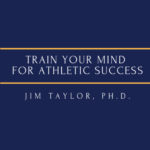Frustration may be your most significant obstacle to achieving your athletic goals. We’ve all experienced the feeling of frustration when we’re not able to do something as we pursue our goals; we feel stuck, we get uptight, and we have difficulty focusing. The best way I can describe the feeling is: AAARRGGHH!! It is a truly infuriating feeling.
But what is frustration precisely and what causes it? Simply put, frustration arises when the path toward your goal is blocked. Most athletes and coaches think of frustration as a bad emotion, but it is actually more complex than that. The fact is that frustration is hard wired into us and has tremendous adaptive value. Frustration starts as a good emotion because when we get frustrated, we are motivated to remove the obstacle that is blocking our path toward our goals. We try harder and that extra effort frequently results in clearing that path enabling us to continue to pursue our goals.
Negative Emotional Chain
Unfortunately, if, despite our best efforts, we can’t overcome those roadblocks, frustration can become a destructive emotion. In fact, if frustration isn’t dealt with effectively and quickly, it can trigger what I can the “negative emotional chain” in which frustration leads to a descent into a series of truly unhealthy emotions.
If frustration isn’t dealt in a productive way, it can morph into anger. Most athletes and coaches also believe that anger is a bad emotion, but, like frustration, it too has both positive and negative sides. Anger starts out as being helpful because it too is motivating. When you are angry, you want to go after the thing that is causing your anger, for example, an inability to master a new skill in your sport. Unfortunately, for most sports, anger swiftly becomes a harmful emotion. The feelings of anger are like those of frustration, but with the volume turned up considerably. Your body becomes tense so if you play a complex motor skill sport such as golf or tennis, you lose your coordination and the quality of your performance decline. Your focus narrows so much that you miss important cues necessary to perform your best. And your thinking becomes clouded by the anger, so you aren’t able to think clearly or make good decisions.
If you’re not able to clear the obstacles from your path at this point, your emotions shift to the final stage of the negative emotional chain; you experience despair. You have tried and tried and tried and still can’t remove the barriers, so the natural thing to do is quit. What’s the point of continuing to try if nothing you do works? The unfortunate outcome of the conclusion of the negative emotional chain is immediate failure to achieve your goals.
It has been my experience that if you move from frustration to anger, continued efforts that day usually fail. And if you experience the negative emotional chain on a regular basis – sinking repeatedly into despair – you will likely lose your motivation and be unwilling to make a sustained effort in the future. With each descent down the negative emotional chain, you come to believe that your actions have little effect and you will progressively lose confidence in your ability to achieve your goals.
Parents’ Role
How young athletes deal with frustration is influenced by how their parents react to it. If parents model an unhealthy response to the frustration they experience in their lives, for example, with impatience or anger, athletes may learn that this is an appropriate way to deal with frustration. If parents are calm, positive, and look for solutions when they get frustrated, young athletes will likely adopt this approach to frustration.
How parents respond to their young athletes’ frustration will also affect how they learn to deal with their frustration. If parents become impatient and angry with their children, their frustration may escalate and more quickly turn into anger and despair, further preventing the young athletes from resolving the source of their frustration. If parents respond to their children’s frustration by asking them in a soothing voice what they are frustrated about and discuss how they want to help them deal with it, then the young athletes are more likely to calm down and follow their parents’ lead in looking for a solution to their frustration.
Teaching Frustration Mastery
Despite the fundamental role that frustration plays in your efforts to be your best, you probably haven’t been shown how to deal with your frustration in a constructive way. Your goal is to learn to stop the negative emotional chain at frustration by responding positively to the frustration when it first arises.
The first mistake that many athletes make when faced with frustration is to just increase their effort, in other words, do whatever they were doing more and harder. But then they are violating the Law of Insanity: doing the same thing and expecting different results.
When frustration first arises, rather than plowing ahead, you should do just the opposite, in other words, step back from the situation that is causing the frustration. For example, if you just can’t seem to get a new technical skill in your sport that you are practicing, set it aside and take a break. Stopping the activity creates emotional distance from the frustration, thus easing its grip on you.
Next, do something that is fun and relaxing during the break, for example, getting a snack (hunger is a significant cause of frustration, particularly among young athletes), listening to music, or talking to friends. This step lessens the uncomfortable physical symptoms that come with frustration and generates emotions, such as happiness or excitement, that can counteract the feelings of frustration. A powerful way to counter the feelings of frustration when you have stepped back from the activity is to do something at which you can succeed, for example, some aspect of your sport at which you are very good, thus feeding your feelings of confidence and generating positive emotions such as pride and inspiration.
Once the negative emotional chain has been broken, return to the activity with a focus on understanding the problem. If they know what the specific problem is, then you have a better chance at finding a solution. The final step is to find a solution to the problem. Though you want to give yourself plenty of opportunity to identify the problem and find the solution yourself, I encourage you to reach out to coaches, parents, and others to help you find the solution to the problem that is causing your frustration. Here’s a helpful hint: sometimes it’s useful to break down the bigger problem into smaller, more manageable problems.
But the reality is that you can’t always immediately clear the obstacles to your goals, so continued efforts in pursuit of those goals would be futile and descent along the negative emotional chain would be likely. The barriers may be just too great to surmount on that day. You have two options here. First, you can change your goals to ones that can be achieved in the short term. For example, let’s say you’re frustrated because you’re losing a tennis match and nothing you can do will turn the match around. In this case, continuing to pursue the goal of winning will likely take you quickly along the negative emotional chain. But if you shifts your goals, for instance, focusing on improving a technical or tactical part of your game, you can still experience some success and get something out of the match.
Second, there are going to be days when you just aren’t going to make any progress toward your goals and continuing to try without success will only discourage you and actually hurt your efforts in the long run. In this case, it may be wise to deliberately “give up” and choose to fight another day.





